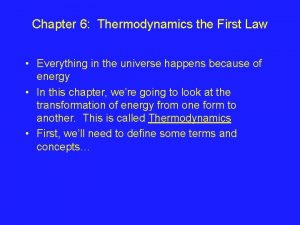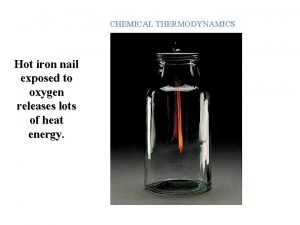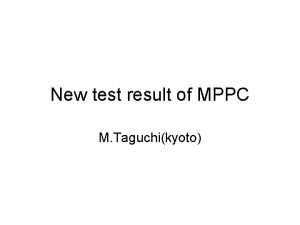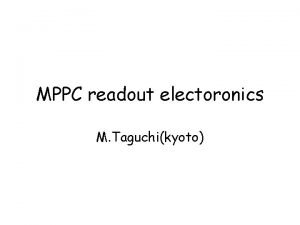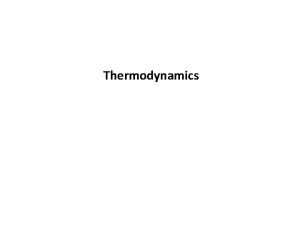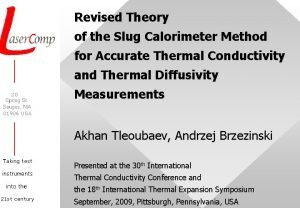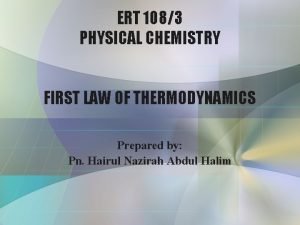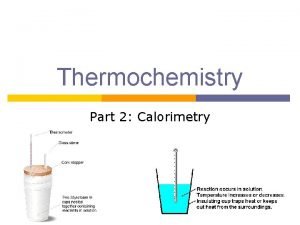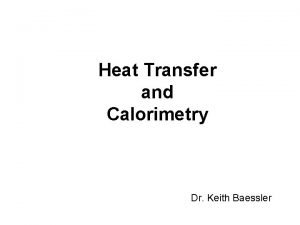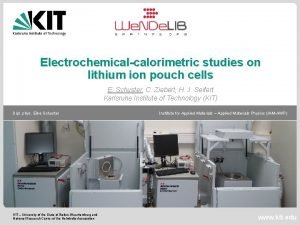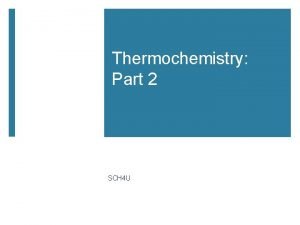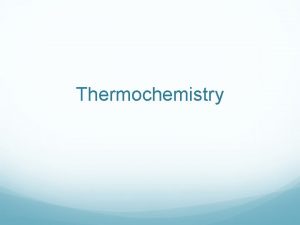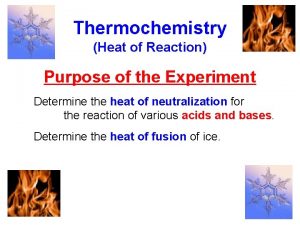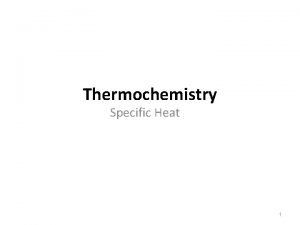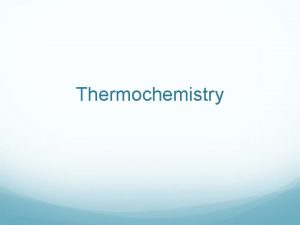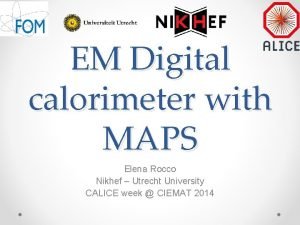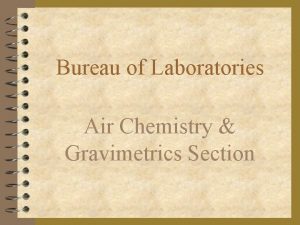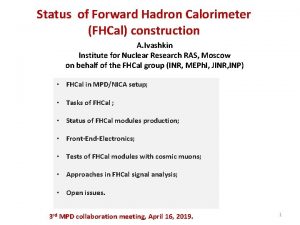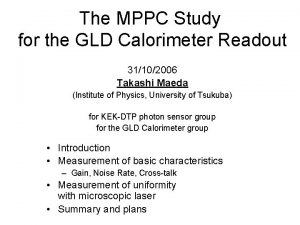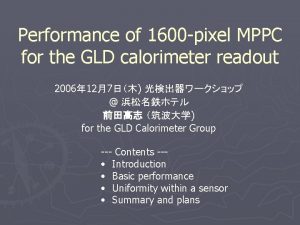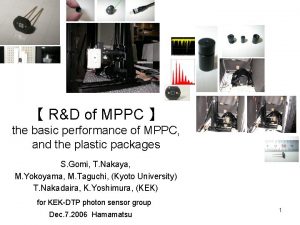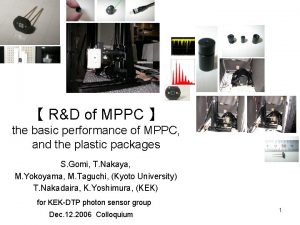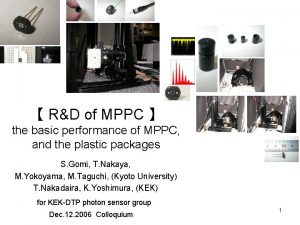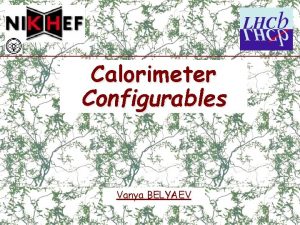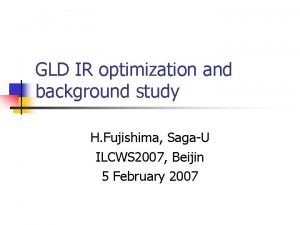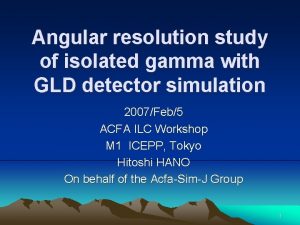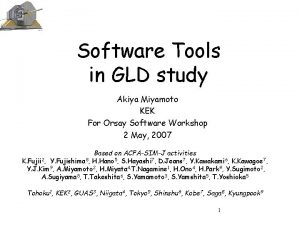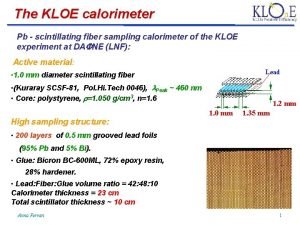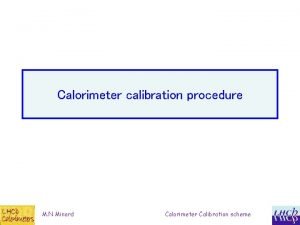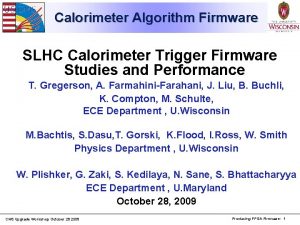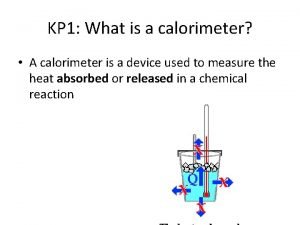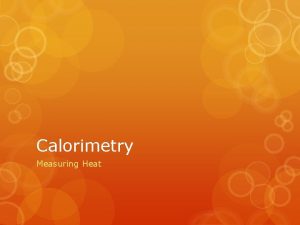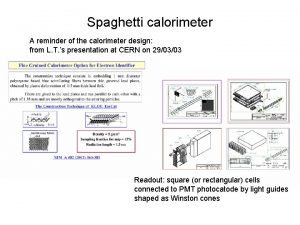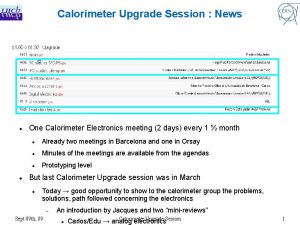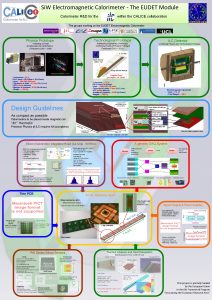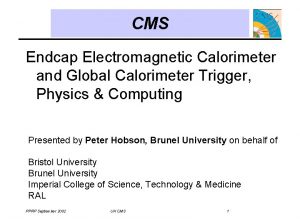Study of the MPPC for the GLD Calorimeter


























- Slides: 26

Study of the MPPC for the GLD Calorimeter readout Satoru Uozumi (Shinshu University) Feb 3 -8 2007 LCWS @ Beijing • Introduction • Basic performances • Future improvements • Summary

The GLD Calorimeter • Sampling calorimeter with Pb/W - scintillator sandwich structure with WLSF readout • Particle Flow Algorithm (PFA) needs particle separation in the calorimeter • Fine granularity with strip/tile scintillator • Huge number of readout channels – ~10 M (ECAL) + 4 M (HCAL) ! – 10 K for muon detector • Used inside 3 Tesla solenoid Need a new photon sensor which is compact and low-cost, and has enough performance.

The Multi Pixel Photon Counter (MPPC) - A novel semiconductor photon sensor ~ 1 mm 1600 pixel MPPC Depletion region ~ 2 mm Substrate Si Resistor Guard ring np+ n+ Vbias Al conductor p- substrate p+

4 mm 1. 3 mm Side Excellent photon counting ability 0, 1, 2, 3, 4, 5, 6, 7, . . . Photoelectrons ! Front 1 photoelectron 2 photoelectrons

The MPPC has lots of advantages Photomultiplier MPPC Gain ~106 105~106 Photon Detection Eff. 0. 1 ~ 0. 2 ~0. 2 for 1600 pix. MPPC Response fast Photon counting Yes Great Bias voltage ~ 1000 V ~ 70 V Size Small Compact B field Sensitive Insensitive Cost Very expensive ! Not very expensive Dynamic range Good Determined by # of pixels Long-term Stability Good Unknown Robustness decent Unknown, presumably good Noise (fake signal by thermions) Quiet Noisy (order of 100 k. Hz) The MPPC is a promising photon sensor, and feasible for the GLD Calorimeter readout !

Basic performance • Gain and its variation over 400 MPPCs • Dark Noise Rate • Cross-talk • Photon Detection Efficiency

The MPPC Gain LED MPPC 400 pixel with x 63 amp • 30 o. C • 25 o. C • 20 o. C • 15 o. C • 10 o. C • 0 o C • -20 o. C Pedestal 1 p. e. d 2 p. e. 3 p. e. Over-voltage – C … Pixel capacity – V 0 … Breakdown voltage

Variation of C and V 0 over 400 MPPCs Number of samples Measured at 15 o. C RMS ~ 0. 4 V RMS ~ 3% Breakdown voltage Pixel capacity • 400 MPPCs have been delivered for a coming ECAL beamtest, and we have measured all of them. • Obserbed variation of breakdown voltage is small enough and acceptable.

Rate of Dark Noise Dark noise : Avalanche signal caused by thermal electrons 0. 5 p. e. Threshold • • 30 o. C 25 o. C 20 o. C 15 o. C 10 o. C -20 o. C Threshold 0. 5 p. e. • Dark noise rate increases with over-voltage. • It is also affected by temperature. • Typical noise rate is order of 100 k. Hz with 1600 pixel MPPC.

Cross-talk The inter-pixel cross-talk to adjacent pixels is caused by photons created in an avalanche. Method to measure: 2 pixels fired signals in dark noise is caused by the crosstalk effect. • • 30 o. C 25 o. C 20 o. C 15 o. C 10 o. C -20 o. C Cross-talk prob. increases with over-voltage, but not affected by temperature.

Photon Detection Efficiency (P. D. E) • Q. E. : Probability of electron-hole production by single photon • e. Geiger : Probability that a photoelectron induces an avalanche • egeom : Fraction of sensitive region in a sensor ( Geometrical Efficiency) Measurement method • Inject same light pulse into both MPPC and PMT, and compare light yield measurede by MPPC and PMT. MPPC ~ 16 % PMT WLSF LED 0. 5 mm f Pin-hole

Photon Detection Efficiency @ 25 o. C • P. D. E of the MPPC is ~20%, which is comparable to PMT (for 1600 pixel). • Dominant uncertainty comes from uncertainty of PMT’s P. D. E.

So the MPPC is satisfactory for the GLD calorimeter readout? Requirements for the GLDCAL readout • Gain: ~ at least 105 • Dynamic range: satisfactory to measure EM shower maximum – need ~5000 pixels • Photon Detection Efficiency should be comparable to PMT to distinguish MIP signal • Noise rate : < 1 MHz (threshold = 0. 5 or 1. 5 p. e) • Small package suitable to attach to the scintillator strips • good uniformity, small cross-talk • Timing Resolution ~ 1 nsec – Necessary for bunch ID, slow neutron separation • Should be stable against bias voltage / temperature / time • Price ! The MPPC is feasible for the GLD calorimeter, but still need more improvements.

Improvement is ongoing We are improving the MPPC collaborating with Hamamatsu photonics. Evaluate performance of the MPPC prototypes Provide feedback, requirements and suggestions to HPK Improved samples from HPK We are still improving performance of the MPPC. In some future we will have the MPPC with sufficient performance for our requirements.

If you are interested in the MPPC … Yes, now you can buy it ! Number of pixels Sensor size Nominal Bias Volt. Gain (x 105) 100 400 1 x 1 mm 2 70 10 V 24. 0 7. 5 Noise Rate (k. Hz) 400 65 % Photon Detection Efficiency Temperature dependence (DV 0/DT) 270 50 % 1600 77 10 V 2. 75 100 25 % 50 m. V / o. C (Numbers from HPK catalog) • Hamamatsu is starting to deliver the MPPC. See following page for more information: http: //www. hamamatsu. com/news/2006_1 0_26. html

Summary • The Multi Pixel Photon Counter is a new and promising photon sensor. • It has many advantages comparing with photomultiplier and suitable for the GLD calorimeter readout. • However there are still some points necessary to be improved (dynamic range, temperature dependence, etc. . ) • We are improving these points with Hamamatsu photonics and we will have a sufficient performance in future. Plans • Perform a ECAL beam test with full MPPC readout (g next talk). • After the beam test, we will study robustness, long-term stability, radiation hardness, magnetic field tolerance, timing resolution. • Of course we will continue to improve the MPPC performance collaborating with Hamamatsu.

Backups

Cross-talk probability Noise rate (Hz) Over voltage (Vbias-V 0)

Temperature dependence of V 0 DV 0/DT = (56. 0 ± 0. 1) m. V/o. C

KEK Detector Technology Project Photon Sensor Group (http: //rd. kek. jp/) (KEK, Kobe, Kyoto, Nagoya, Nara-WU, NDA, Shinshu, Tokyo/ICEPP, Tsukuba) • Develop and study the MPPC with Hamamatsu • Aiming to have satisfactory performance to use at : – GLD calorimeter – T 2 K near detector – Belle Aerogel Cerenkov Counter • Provide important feedbacks to Hamamatsu for improvement of fundamental properties

Noise Rate, Cross-talk probability Noise rate (k. Hz) >0. 5 p. e. Cross-talk = NR(>1. 5 p. e. ) NR(>0. 5 p. e. ) >1. 5 p. e. Bias voltage (V)

MPPC mass measurement Blue LED Bias voltage source MPPC board Shaper & Amp Thermostatic chamber Discri (kept at 15 o. C) MPPC ADC Scaler

Variation of Noise Rate, Cross talk over 400 MPPCs RMS/Mean=60% 23% 21% 27% 39% 23% Cross-talk probability Noise rate (k. Hz) 30% RMS/Mean=27% 47% 58% 63% 59% 70% 48% Bias voltage (V) • Error bars mean variation (RMS) over 400 MPPCs

Photon Detection Efficiency by Hamamatsu

Need More Dynamic Range ! 1600 pixel Response curve (simulation) Light input (photoelectrons) • The MPPC is a non-linear device. • One pixel can count only one photon, even if there are 2 or more photons injected. • Need to increase number of pixels to improve the dynamic range. (currently 1600 pixels is maximum) About 5000 pixels is necessary to measure high energy electromagnetic shower maximum

The MPPC is drastically evolving … Mar. 2005 100/400 pixels ●First sample from Hamamatsu ● Jan. 2006 100/400/1600 pixels ●Smaller pixel size results in more number of pixels ● Oct. 2006 100/400/1600 pixels commercialized ●Improved Gain and dark noise ● Sometime in future Larger sensor area ●More number of pixels ●And perhaps more… ● ?
 Coffee cup calorimeter vs bomb calorimeter
Coffee cup calorimeter vs bomb calorimeter Calorimeter problems
Calorimeter problems Coffee cup calorimeter equation
Coffee cup calorimeter equation Rancangan produk rancangan proses dan rancangan skedul
Rancangan produk rancangan proses dan rancangan skedul Mppc
Mppc Contoh routing sheet
Contoh routing sheet Mppc
Mppc Constant volume calorimeter
Constant volume calorimeter Calorimeter formula
Calorimeter formula Slug calorimeter
Slug calorimeter Bomb calorimeter
Bomb calorimeter Unit of bmr
Unit of bmr Bomb calorimeter uses
Bomb calorimeter uses Coffee cup calorimeter equation
Coffee cup calorimeter equation Function of bomb calorimeter
Function of bomb calorimeter Calorimeter
Calorimeter Calorimeter constant
Calorimeter constant Accelerating rate calorimeter
Accelerating rate calorimeter 62g
62g Calorimeter
Calorimeter Combustion reaction
Combustion reaction Homemade calorimeter
Homemade calorimeter Bomb calorimeter
Bomb calorimeter Elena rocco
Elena rocco Now answer these questions
Now answer these questions Parr calorimeter
Parr calorimeter Hadron calorimeter
Hadron calorimeter
